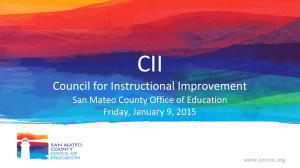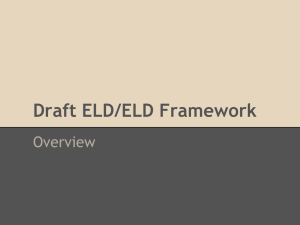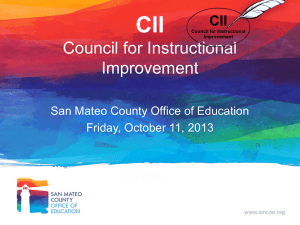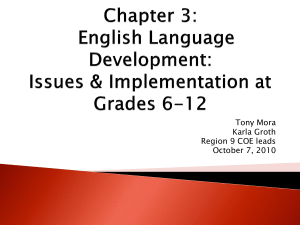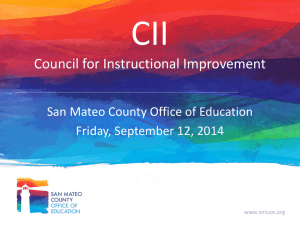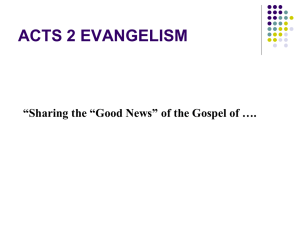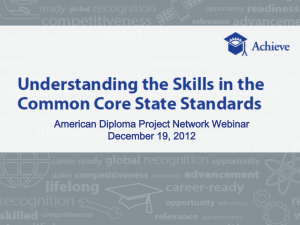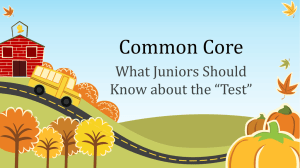PowerPoint - Smcoe.org
advertisement
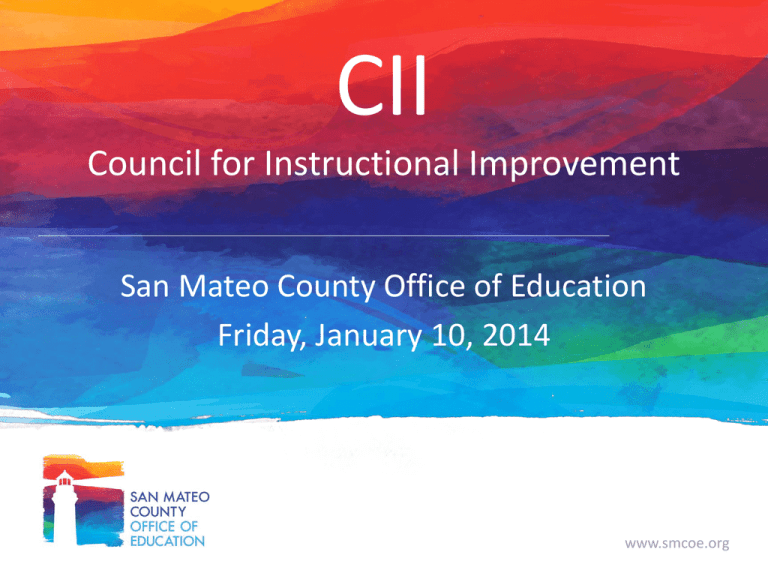
CII Council for Instructional Improvement San Mateo County Office of Education Friday, January 10, 2014 www.smcoe.org AGENDA Welcome, Introductions, Overview Of Agenda Updates ELA/ELD Framework Overview Themes and Context for Implementing the ELA/ELD Common Core State Standards Break Strategies for English Learners Critical Thinking in ELA/ELD Announcements Adjourn www.smcoe.org UPDATES • Introduction of STEM Center Director • CCSS Leadership Series • Professional Development Offerings for Winter/Spring/Summer • Zap the Gap www.smcoe.org ELA/ELD DRAFT FRAMEWORK OVERVIEW www.smcoe.org TIMELINE Event Schedule CFCC completes work September 27, 2013 IQC acts on draft 60-day public review IQC analyzes results, recommends edits 60-day public review SBE acts on draft/public hearing Framework Implementation Smarter Balanced Assessments Instructional Materials Reviews Completed November 21– 22, 2013 Dec 2013 – Feb 2014 Late February 2014 March 2014 – May 2014 July 2014 2014 –2015 2014 –2015 November 2015 STATUTORY REQUIREMENTS CA CCSS for ELA/Literacy CA ELD Standards Students with Disabilities 21st Century Skills Transitional Kindergarten www.smcoe.org DRAFT ELA/ELD FRAMEWORK CHAPTERS • Chapter 1: Introduction to the Framework • Chapter 2: Overview of the Standards • Chapter 3: Key Considerations in the ELA Literacy and ELD Curriculum, Instruction, and Assessment • Chapter 4: Content and Pedagogy: Transitional Kindergarten and Grade 1 • Chapter 5: Content and Pedagogy: Grades 2 and 3 • Chapter 6: Content and Pedagogy: Grades 4 and 5 www.smcoe.org CHAPTERS Continued • • • • • Chapter 7: Content and Pedagogy: Grades 6 - 12 Chapter 8: Assessment Chapter 9: Equity and Access Chapter 10: Learning in the 21st Century Chapter 11: Implementing High-Quality ELA/Literacy and ELD Instruction: Professional Learning, Leadership, and Program Supports • Chapter 12: Instructional Materials to Support the CA CCSS for ELA/Literacy and CA ELD Standards • Resources and Glossary www.smcoe.org IMPLICATIONS Integration Reading, Writing, Speaking and Listening, and Language ELA/ELD (Integrated and Designated) 21st Century Skills Content Areas Assessment and Planning Collaboration Professional Learning www.smcoe.org HELPFUL WEB SITES Common Core State Standards California English Language Development Standards http://www.cde.ca.gov/sp/el/er/eldstandards.asp CCSS Professional Learning Modules for Educators http://www.cde.ca.gov/re/cc/ http://www.cde.ca.gov/re/cc/ccssplm.asp ELA/ELD Curriculum Framework http://www.cde.ca.gov/ci/rl/cf/ www.smcoe.org Implementing the ELA and ELD CCSS Tracy Wilson twilson@smcoe.org Katherine Strach Kstrach@smcoe.org www.smcoe.org THEMES AND CONTEXTS FOR IMPLEMENTING THE ELA/ELD COMMON CORE STANDARDS Framework Table of Contents Chapter 3 Key Considerations in ELA/Literacy and ELD Curriculum, Instruction, and Assessment Annotate the text: 3 2 1 3 -Observations 2 -Wonders 1 -Question www.smcoe.org CCSS TK-Grades 1 ELA Framework Decades of research indicate that knowledge contributes to reading and writing achievement. The more an individual knows about a topic, the more success he or she will have engaging meaningfully with text and others about the topic. Furthermore, knowledge of subject matter is accompanied by, indeed, cannot be separated from, language development. Words, sentence structures, and discourse structures differ across subject matter (Shanahan and Shanahan 2012) and so content learning contributes to the development of language, especially academic language. In short, content knowledge facilitates literacy and language development. On the other hand, literacy and language development provide students with the tools to independently access, acquire, and construct domain and general world knowledge. The more skilled children are in the language arts (that is, reading, writing, speaking, listening), the more they can learn about the world. Two points about content area instruction are crucial. First, content area instruction must be given adequate time in the school day, including during the earliest years of schooling. Second, content area instruction should include attention to literacy and language development in the subject matter. www.smcoe.org GOALS, THEMES, AND CONTEXTS FOR IMPLEMENTATION OF THE CA CCSS FOR ELA/LITERACY AND THE CA ELD STANDARDS www.smcoe.org WHAT? CCSS Clear and progressive learning objectives that are integrated and routinely practiced across content areas Reading Writing Speaking and Listening Language Reading Foundations www.smcoe.org WHAT IS IMPORTANT? www.smcoe.org WHAT? Clear and progressive learning objectives that are integrated and routinely practiced across content areas Longitudinal View Planning with two-way vision • Develop deep outcome awareness, anchor standard • Growth model: Assess current student readiness and design learning targets to grow competence www.smcoe.org WHAT? Clear and progressive learning objectives that are integrated and routinely practiced across content areas Planning with a Longitudinal View DO Now: Select a lesson objective, CCSS. Use the CCSS progression resources to develop appropriate learning targets for emerging students and developed students. • TCOE: ELA CCCCSS Continuums • http://www.tcoe.org/ers/ccss/ela/resources.shtmwww.smcoe.org WHAT? Clear and progressive learning objectives that are integrated and routinely practiced across content areas Do Now: Examine “curriculum” guides Look for evidence of… 6 T’s 1. 2. 3. 4. 5. 6. Theme: Integration- How is the lesson/unit developed to build knowledge? Texts: F/NF? Quality? Universal Access? Developmentally appropriate texts? Tasks: CCSS- aligned, Rigor and Relevant? Text-driven? Integrated literacies? Talk: Build language awareness and capacity? Academic vocabulary? Time: Sufficient time on task/text to develop increasing independence? Tests: What is being monitored? Strategic learning targets, short/long term? www.smcoe.org MOVING FORWARD! Sweep or Keep Texts Sweep: material that does not meet enough of the criteria to keep it; it may be poorly developed, or loosely connected to a theme, or does not build knowledge or human understanding, or does not lend itself well to a series of focused lessons Keep: material that is strong in a variety of capacities; rich, relevant, promotes critical conversation, elicits strong writing, easily connected to other standards and helps build knowledge Modify or Magnify Practices Modify: needs to be altered to be aligned with the more rigorous/relevant expectations of the CCSS or needs to modified to be an effective component of the lesson strand Magnify: should be elevated because it is a strong component of the lesson but it is often over-looked or under played www.smcoe.org WHAT? Outcomes Crosscutting behaviors of students Making Meaning Developing Language Expressing Themselves Effectively Building Content Knowledge Developing Strong Foundational Skills www.smcoe.org ENGLISH LANGUAGE DEVELOPMENT www.smcoe.org ENGLISH LANGUAGE DEVELOPMENT Integrated ELD Content instruction that supports development of language uses specified in CCSS for ELA/Literacy & CA ELD Standards Designated ELD Specialized instruction that builds into and from content instruction in ELA and other disciplines www.smcoe.org WHAT? What is Important? Determining and describing observable student behaviors consistent with the demands of the CCSS Do Now, Lesson Study: Use the lesson vignette to identify examples of… 1. Making Meaning 2. Developing Language • • • Expressing Themselves Effectively Building Content Knowledge Developing Strong Foundational Skills www.smcoe.org HOW? Effective Learning Environment Teachers intentionally and reflectively craft the learning environment Intellectually challenging contexts Integrated learning experiences Motivating environments Engaging texts, tasks and talk Respectful learning opportunities for all www.smcoe.org Integrated ELD ACROSS THE DISCIPLINES, EL EXPERIENCES • Are interactive and engaging, meaningful and relevant, and intellectually rich and challenging • Are appropriately scaffolded in order to provide strategic support that moves learners toward independence • Build both content knowledge and academic English • Value and build on primary language and culture and other forms of prior knowledge www.smcoe.org Integrated ELD INSTRUCTIONAL PLANNING • Routinely examine the texts and tasks used for instruction in order to identify language that could be challenging for ELs • Determine where there are opportunities to highlight and discuss particular language resources • Observe students to determine how they’re using the language teachers are focusing on • Adjust whole group instruction or work with small groups or individuals in order to provide adequate and appropriate support www.smcoe.org HOW? Effective Learning Environment Teachers intentionally and reflectively craft the learning environment Next Steps: Develop rituals and routines that support instruction in language awareness and that build language capacities www.smcoe.org Integrated ELD SCIENCE: SUPPORT COMPREHENSION OF COMPLEX TEXTS Original sentence to unpack: “Although many countries are addressing pollution, environmental degradation continues to create devastating human health problems each year.” Meanings: What this sentence is mostly about: What it means in our own words:/ELD Framework, www.smcoe.org Integrated ELD SCIENCE: SUPPORT COMPREHENSION OF COMPLEX TEXTS Original sentence to unpack: “Although many countries are addressing pollution, environmental degradation continues to create devastating human health problems each year.” Meanings: (DO Now- Add 2) • • • • Pollution is a big problem around the world. A lot of countries are doing something about pollution. ... … www.smcoe.org Integrated ELD SCIENCE: SUPPORT COMPREHENSION OF COMPLEX TEXTS Original sentence to unpack: “Although many countries are addressing pollution, environmental degradation continues to create devastating human health problems each year.” Meanings: Pollution is a big problem around the world. People are creating pollution and ruining the environment. The ruined environment leads to health problems in people. Health problems are still happening every year. The health problems are really, really bad. A lot of countries are doing something about pollution. What this sentence is mostly about: Environmental degradation What it means in our own words: Do Now, summarize www.smcoe.org Integrated ELD SCIENCE: SUPPORT COMPREHENSION OF COMPLEX TEXTS Original sentence to unpack: “Although many countries are addressing pollution, environmental degradation continues to create devastating human health problems each year.” Meanings: Pollution is a big problem around the world. People are creating pollution and ruining the environment. The ruined environment leads to health problems in people. Health problems are still happening every year. The health problems are really, really bad. A lot of countries are doing something about pollution. What this sentence is mostly about: Environmental degradation What it means in our own words: People are creating a lot of pollution and messing up the environment all around the world, and even though a lot of countries are trying to do things about it, a lot of people have big health problems because of it. --ELA/ELD Framework, Ch.3, p. 74 www.smcoe.org Designated ELD ELD: DEVELOP LANGUAGE RESOURCES Sentence: Analysis: Meaning: Broken into clauses Type of clause and how I know What it means Although many countries Dependent (subordinate are addressing pollution, clauses) It starts with “although,” so it can’t stand on its own. It depends on the other clauses. --Independent (main clause) --environmental degradation continues to create devastating It can stand on its own, even human health problems if I take the other clause each year. away. The clause is giving credit to a lot of countries for doing something about pollution. --The clause has the most important information. Pollution keeps hurting a lot of people every year all over the world. --ELA/ELD Framework, Ch. 3, pp. 79-80 www.smcoe.org HOW? What is Important? Designing an engaged classroom and an effective learning environment http://www.engageny.org/resource/close-reading-strategies-with-informational-text-by-expeditionarylearning Do Now: 2-Way Observation 1. Learning focused observation: Observe the studentsHow do you know they are engaged and that the learning environment is effective for all students? 2. Teaching focused observation: Observe the teacherWhat rituals and routines are in place to support student engagement and effective learning opportunities? www.smcoe.org EFFECTIVE LEARNING ENVIRONMENT www.smcoe.org WHY? Students who are broadly literate and ready for college, career and citizenship in the 21st century Demonstrate independence Build strong content knowledge Respond to varying demands of audience, task, purpose, and discipline Comprehend as well as critique Value and use evidence Use technology and digital media strategically and capably Understand other perspectives and cultures www.smcoe.org WHY? What is Important? Designing curriculum that promotes critical literacies in readiness for 21st century contexts. Do Now: Collaboration, audit your lesson vignette or rethink the video What would you do to enhance or enrich learning? Students develop critical thinking when they Students develop creative thinking when they Students develop communication and collaboration skills when they Students develop social and cross-cultural skills and global competence when they Students develop technology skills when they www.smcoe.org THEMES AND CONTEXTS FOR IMPLEMENTING THE ELA/ELD COMMON CORE STANDARDS WHAT: Clear and progressive learning objectives and learning outcomes HOW: Engaging and Effective Learning Environment WHY: Broadly Literate Students Ready for the 21st Century www.smcoe.org THEMES AND CONTEXTS FOR IMPLEMENTING THE ELA/ELD COMMON CORE STANDARDS Next Steps Design progressive learning targets Audit curriculum resources, 6 T’s Construct rituals and routines 2-Way Observations Collaborative lesson study and development www.smcoe.org NEXT MEETING: February 7th, 2014 Common Core State Standard Mathematics with David Foster www.smcoe.org
